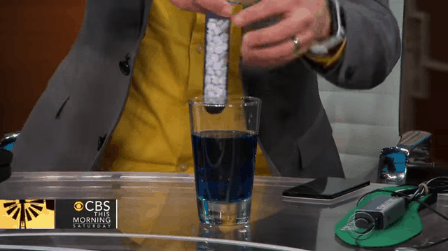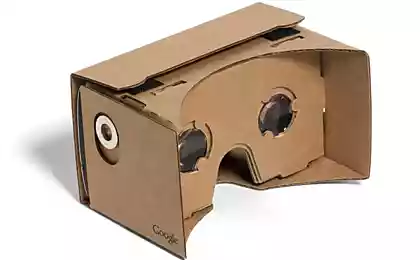1689
6 inventions that could save your life

Edition Inhabitat i> usually tells about the technologies that are they seem to be able to save the world. However, many scientists, engineers, computer geniuses and designers around the world are engaged in global issues not only save the planet, but also more mundane, that is, in other words, trying to make us healthier, and our lives easier. Here are six designs, which according to the Inhabitat i> has a chance ever to save our lives.
1. Syringe, stops bleeding h4> If someone gets a bullet wound, fast and efficient delivery of health care is a matter of life and death. Syringe XStat i> able to stop the bleeding from an artery for what some 15 seconds. Sponges, which are introduced into the wound, expanding rapidly and stop the blood.
This syringe developed by Revmedx i> in conjunction with physicians US Special Forces. Application of the technology are planning to expand to other types of wounds.
Began development of a syringe for military purposes. On the battlefield, the complexity caused injury in areas in which the wound can not be pinched for example, the sacrum and underarms. To stop the bleeding in these areas was not special means, and Revmedx i> to tackle the problem. The technology is based on using small sponges, which are introduced into the wound with an applicator or a diameter of 30 to 120 mm, similar to a syringe. The sponges in contact with blood dilate stopped bleeding within 20 seconds and the wound is pressed. On each sponge has a label distinguishable with X-rays. The same technology used for the planning application in other types of wounds.
Actions XStat i> is enough for about 4 hours, giving enough time for transportation of the victim and to prepare for surgery. In XStat i> has its drawbacks: it can not be used in the thorax, abdomen, clavicles, and others.

source i>
Diabetes - a disease that affects every person on the planet nineteenth. Therefore, developers are all sorts of innovations can not pass by this problem. Patients have to constantly monitor blood sugar levels, which implies unpleasant procedures that have to regularly. Here are a couple of promising developments aimed at in order to facilitate this process. Blockquote>
2. Lenses from Google i> watch over health h4> Google is developing contact lenses that monitor blood glucose levels. In the future, teach them how to prevent its owner when the sugar level is raised or lowered the allowable limit.
In the lens is built miniature sensor and a tiny wireless chip that react to changes in blood sugar levels.
Sugar level can be determined by the tears on that and drew attention to the Google i>. Built-in sensors and chips are placed between two layers of the lens itself. LEDs are also built into the lens will flash when the sugar level reaches the danger mark. The prototype lens, the active development of which was reported in January 2014, was supposed to fix the level of sugar in the blood of times per second.
In addition to the lens itself was planned to develop an application that will simultaneously inform the blood sugar and diabetic wearing the lenses, and his doctor.

Источник
3. Tattoos with nanoparticles h4> People with diabetes need to regularly pierce their fingers, which is inconvenient, uncomfortable, and the method is not very accurate. In MIT i> found an alternative: the level of glucose can keep the tattoo. Specially designed ink tattoo can be applied, and bracelet will inform about troubles.
MIT i> is developing a device that could be just to wear for yourself. Its action is based on the use of carbon nanotubes, which are not destroyed by the light of day, wrapped in a polymer that is sensitive to fluctuations in sugar. When interacting with glucose sensor will light that can be detected in the emission of near-infrared waves. Should be included in the nanotube ink formulation, and the infrared rays directed at the tattoo, bracelet provide, like a wristwatch. Tattoo require updates about once every six months. And, of course, require careful validation of this device, so that development can take many years.
source i>
4. Drones ambulance h4> Medical drone can fly to the aid of one minute and thereby save someone's life. With him he can carry a first aid kit, defibrillator or a device for cardiopulmonary resuscitation, and is also equipped with a camera, which allows medical staff to supervise the actions of eyewitnesses.
Drone rid of the hassles that can trap on the way to the affected ambulance. Its coverage is 12 km 2 sup>. Author of the project, Alec Momont, hopes to significantly reduce the number of deaths, coming from the fact that the ambulance does not have time to patient. Load capacity drone is about four kilograms that allows you to deliver the scene required a medical device. People can normally call for an ambulance, and a minute later to them drone fly, not only with a medical kit, but with a camera that allows the operator to monitor the situation and talk to people who find themselves in the vicinity, how to help the victim while waiting ambulance.
Источник
5. Pacemaker new generation h4> The current pacemakers are far from perfect, but the new technology developed by Urbana-Champaign i> in Illinois can change the future of devices saves lives. The development team created a thin membrane permeated sensors and electrodes. The pacemaker will fit on the size of each particular heart and keep it running.
After steps, which used high-resolution imaging and computer modeling, the 3D-printer model was created in the heart, in which the membrane was first tried. Then, tests were conducted on rabbit heart.
According to the developers, similar to a pacemaker pericardial sac and skintight heart. He will be able to constantly monitor the electrical activity of the heart, and if necessary, by applying an electrical pulse to the desired location of the heart, stop the arrhythmia and prevent heart attacks.
The developers say that the work on a pacemaker can be completed in 10 - 15 years.

Источник
6. Organovo and 3D-bodies h4> Daily 79 people transplanted some organ, and the same day 18 people die, and not waiting for your donor. The company Organovo i>, based in San Diego, to improve this situation, trying to develop the technology 3D-printing to create human organs. At present they have managed to print a small kidney.
The company Organovo i> known printable fabrics that have become widely available and accepted by scholars and researchers. The company's goal is to accelerate the research process and cheaper medicines. Printed on 3D-printer fabric allow to observe directly, as well as how effective and safe being treated one way or another drug, and, of course, these fabrics allow to avoid discussion about whether it is ethical experience in this field over the animals.
Now that create miniature kidney, a little closer the prospect of print organs for transplantation.

source i>
Source: geektimes.ru/company/vertdider/blog/244396/



























